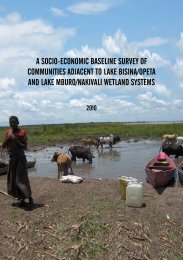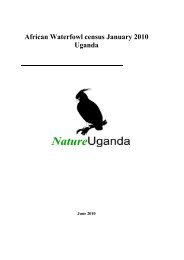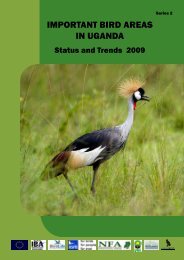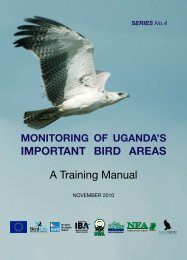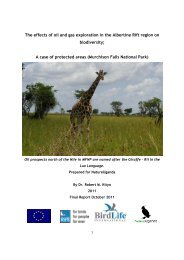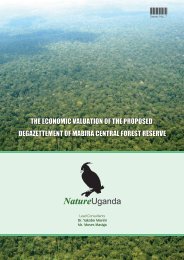A Ecological Baseline Surveys Of: - Lake Bisina - Nature Uganda
A Ecological Baseline Surveys Of: - Lake Bisina - Nature Uganda
A Ecological Baseline Surveys Of: - Lake Bisina - Nature Uganda
You also want an ePaper? Increase the reach of your titles
YUMPU automatically turns print PDFs into web optimized ePapers that Google loves.
Factors such as temperature, electrical conductivity, dissolved oxygen; turbidity and pH interact to<br />
influence the abundance and distribution of biodiversity in wetland ecosystems. Variation in these<br />
parameters is influenced by the underlying geology, climatic factors, and land-use practices within<br />
the landscape. For example conductivity may increase in wetlands draining intensively cultivated<br />
watersheds and urban areas. An assessment was carried out on the above parameters in order to<br />
establish their baseline condition and explore possible human impacts on the wetlands.<br />
7.2 Objectives, study sites and methods<br />
7.2.1 Objectives<br />
• Produce guiding methods for each parameter to be used during and after the exercise.<br />
• Establish baseline information on water physical and chemical parameters identified (PH,<br />
electrical conductivity, dissolved oxygen, temperature, turbidity and total dissolved solids)<br />
• Take appropriate GPS coordinates for points from where sampling was done.<br />
• Make field observations and descriptions to support observed values in the field.<br />
• Produce a comprehensive report on the work done.<br />
7.2.2 Study sites:<br />
(a) Opeta-<strong>Bisina</strong> wetland system<br />
It is located in eastern <strong>Uganda</strong>. The wetland system is characterized by open water that is clear<br />
with some emergent vegetation mainly of sedges and floating vegetation dominated by the day<br />
water lily Nymphaea sp and submerged water weeds. Some patches of Cyperus papyrus exist in<br />
areas with minimal agricultural encroachment. The main inflow into the Opeta system is through<br />
River Sironko.<br />
Five sites were sampled on both <strong>Bisina</strong> (3) and Opeta (2). The <strong>Bisina</strong> sites were:<br />
1. Akide landing site. It is located on the north-eastern end of <strong>Lake</strong> <strong>Bisina</strong> and was accessed from<br />
Kumi town. 2) Kakor village landing site. Most of the shore to this site is grazing land and it is located<br />
where waterfowl counts are undertaken (starting point) and 3) Site is located towards the southern<br />
end of <strong>Lake</strong> <strong>Bisina</strong> but on the western shore of the <strong>Lake</strong> overlooking the rocks/hills on Soroti Kumi<br />
road. The point is located where the waterfowl crew usually rests. The two points on Opeta were<br />
located, one on the northern end of the lake at Agule village landing site in Opeta Parish. The<br />
immediate environs of the site are characterized by overgrazing and bush burning seems prevalent<br />
in the area. The second site on Opeta was located on River Sironko to get an insight into the quality<br />
of water flowing into the wetland.<br />
100<br />
<strong>Ecological</strong> <strong>Baseline</strong> <strong>Surveys</strong> of <strong>Lake</strong> <strong>Bisina</strong>, <strong>Lake</strong> Opeta, <strong>Lake</strong> Mburo and Nakivali Wetlands Systems



